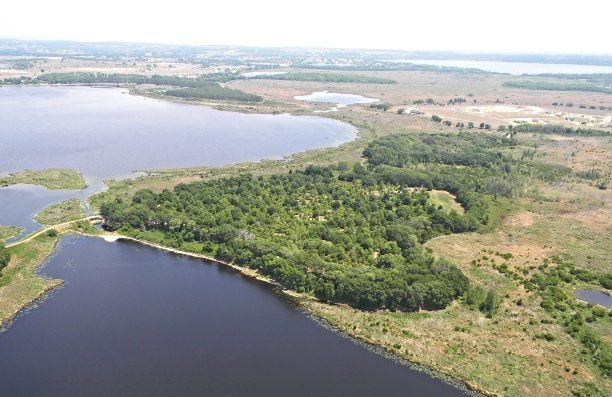Understory
The hammock understory is generally sparse due to the shading of the hardwood canopy and the absence of fire in this typically non-pyrogenic plant community. Various herbaceous and woody weeds, vines, and shrubs are present, most notably American beautyberry, blackberry, and wild grape. These species offer excellent food for wildlife. The USDA reports that the spring growth of the beautyberry is high in crude protein, phosphorus, and calcium. The brightly colored fruit, for which this plant is named, matures in late summer. Many birds including quail, as well as various mammal species eat the purple drupes.
Blackberries are members of the rose family and one of the more important food sources for wildlife in the south. Many birds including turkey and quail utilize the drupe “berries.” Blackberries are shade intolerant, so they grow best where a more open canopy exists or on the edge of the hammocks. They can grow into dense thickets of thorny canes providing good cover for birds and rabbits. Periodic disturbances such as fire or disking can stimulate new cane growth. Prescribed fire is a more realistic option in the young slash pine plantation where blackberries and beautyberries also exist; both can re-sprout following burning.
Wild muscadine grapes are common in many habitats in Central Florida. They grow best in canopy openings or on the edge of the hammocks out of dense shade. They are also found in the pine stands.
Understory Vegetation within the Mixed Hardwood Coniferous Stand
Common Name | Scientific Name | Common Name | Scientific Name | Common Name | Scientific Name |
American Beautyberry | Callicarpa americana | Bahia Grass | Paspalum notatum | Blackberry | Rubus betulifolius |
Bracken Fern | Pteridium aquilinum | Briers | Smilax spp. | Broomsedge Bluestem | Andropogon virginicus |
Caesar Weed | Urena lobata | Common Ragweed | Ambrosia artemisiifolia | Dog Fennel | Eupatorium spp. |
Elephants Foot | Elephantopus tomentosus L. | Grapevine | Vitis rotundifolia | Lantana | Lantana camara |
Lopsided Indiangrass | Sorghastrum secundum | Salt Bush | Baccharis halimifolia L. | Spanish Needle | Bidens pilos |
Black Cherry | Prunus serotina | Cabbage Palm | Sabal palmetto | Carolina Laurel Cherry | Prunus caroliniana Ait. |
Citrus | Citrus spp. | Ear Tree | Enterolobium cyclocarpum | Laurel Oak | Quercus hemisphaerica |
Live Oak | Quercus virginiana | Sand Live Oak | Quercus geminata | Slash Pine | Pinus elliottii |
Water Oak | Quercus nigra | Winged Sumac | Rhus copallinum |
These hammock areas offer ecological and aesthetical diversity. The hammocks offer both food and cover for wildlife. Acorns are an important hard mast for game species. The oaks offer important mast production; many species of birds and mammals readily eat the nuts and acorns, especially the sweeter live oak acorn, which is favored by wild turkey as well as white-tailed deer.
The over-mature, relatively short-lived, laurel oaks are typically in a state of decline – the decaying wood and occasional snags offer opportunities for woodpeckers to feed on beetle grubs and other insects.
The hammock understory is generally sparse due to the shading of the hardwood canopy and the absence of fire in this typically non-pyrogenic plant community. Various herbaceous and woody weeds, vines, and shrubs are present, most notably American beautyberry, blackberry, and wild grape. These species offer excellent food for wildlife. The USDA reports that the spring growth of the beautyberry is high in crude protein, phosphorus, and calcium. The brightly colored fruit, for which this plant is named, matures in late summer. Many birds including quail, as well as various mammal species eat the purple drupes.
Blackberries are members of the rose family and one of the more important food sources for wildlife in the south. Many birds including turkey and quail utilize the drupe “berries.” Blackberries are shade intolerant, so they grow best where a more open canopy exists or on the edge of the hammocks. They can grow into dense thickets of thorny canes providing good cover for birds and rabbits. Periodic disturbances such as fire or disking can stimulate new cane growth. Prescribed fire is a more realistic option in the young slash pine plantation where blackberries and beautyberries also exist; both can re-sprout following burning.
Wild muscadine grapes are common in many habitats in Central Florida. They grow best in canopy openings or on the edge of the hammocks out of dense shade. They are also found in the pine stands.

